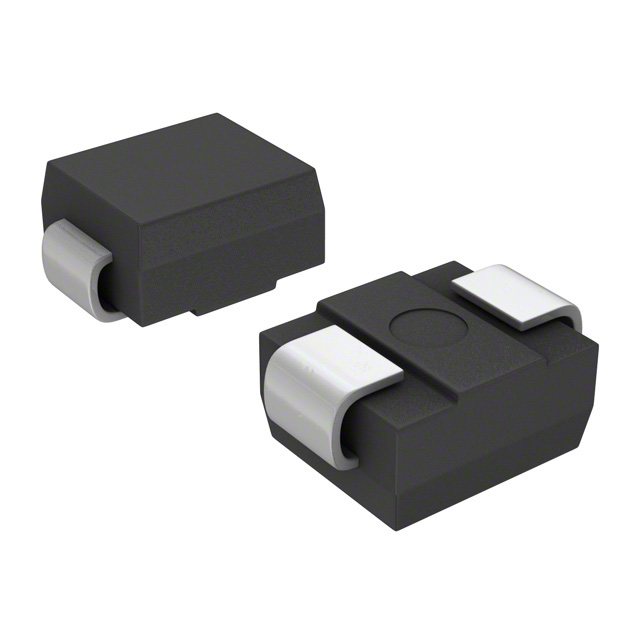Viz Specifikace pro podrobnosti o produktu.

SMBJ12CAHE3/52
Product Overview
The SMBJ12CAHE3/52 belongs to the category of transient voltage suppressor diodes. These diodes are commonly used to protect sensitive electronic components from voltage spikes and transients. The SMBJ12CAHE3/52 is designed to provide robust protection for various electronic circuits and devices. Its characteristics include high surge capability, low clamping voltage, and fast response time. The package type for this diode is SMB, and it is available in tape and reel packaging with a quantity of 1800 units per reel.
Specifications
- Part Number: SMBJ12CAHE3/52
- Category: Transient Voltage Suppressor Diode
- Voltage Rating: 12V
- Peak Pulse Power: 600W
- Package Type: SMB
- Packaging: Tape and Reel
- Quantity per Reel: 1800 units
Detailed Pin Configuration
The SMBJ12CAHE3/52 diode has a standard SMB package with two pins. Pin 1 is the anode, and pin 2 is the cathode.
Functional Features
- High surge capability
- Low clamping voltage
- Fast response time
Advantages and Disadvantages
Advantages
- Effective protection against voltage spikes
- Fast response time ensures minimal impact on the protected circuit
- High surge capability for enhanced reliability
Disadvantages
- May exhibit leakage current at lower voltages
- Sensitive to reverse polarity connection
Working Principles
The SMBJ12CAHE3/52 operates based on the principle of avalanche breakdown. When a voltage spike occurs, the diode rapidly conducts excess current to ground, thereby limiting the voltage across the protected circuit. This action helps prevent damage to sensitive components and ensures the proper functioning of the electronic system.
Detailed Application Field Plans
The SMBJ12CAHE3/52 is widely used in various applications, including: - Power supplies - Communication equipment - Automotive electronics - Industrial control systems - Consumer electronics
Detailed and Complete Alternative Models
Some alternative models to the SMBJ12CAHE3/52 diode include: - P6SMB12CA - 1.5SMC12CA - SMCJ12A
In summary, the SMBJ12CAHE3/52 transient voltage suppressor diode offers reliable protection against voltage transients and spikes, making it an essential component in safeguarding sensitive electronic circuits and devices across diverse industries.
Word Count: 330
Seznam 10 běžných otázek a odpovědí souvisejících s aplikací SMBJ12CAHE3/52 v technických řešeních
What is the SMBJ12CAHE3/52?
- The SMBJ12CAHE3/52 is a surface mount transient voltage suppressor diode designed to protect sensitive electronic components from voltage spikes and transients.
What is the maximum peak pulse power of the SMBJ12CAHE3/52?
- The maximum peak pulse power of the SMBJ12CAHE3/52 is 600 watts.
What is the breakdown voltage of the SMBJ12CAHE3/52?
- The breakdown voltage of the SMBJ12CAHE3/52 is 12 volts.
What are the typical applications of the SMBJ12CAHE3/52?
- The SMBJ12CAHE3/52 is commonly used in applications such as telecommunications equipment, industrial automation, and power supplies to protect against voltage transients.
What is the operating temperature range of the SMBJ12CAHE3/52?
- The SMBJ12CAHE3/52 has an operating temperature range of -55°C to +150°C.
What is the response time of the SMBJ12CAHE3/52?
- The response time of the SMBJ12CAHE3/52 is very fast, typically responding within nanoseconds to clamp voltage transients.
Is the SMBJ12CAHE3/52 RoHS compliant?
- Yes, the SMBJ12CAHE3/52 is RoHS compliant, meaning it meets the Restriction of Hazardous Substances directive.
What is the package type of the SMBJ12CAHE3/52?
- The SMBJ12CAHE3/52 comes in a DO-214AA (SMB) package.
Can the SMBJ12CAHE3/52 be used for overvoltage protection in automotive electronics?
- Yes, the SMBJ12CAHE3/52 can be used for overvoltage protection in automotive electronics due to its high surge capability and fast response time.
What are the key features of the SMBJ12CAHE3/52?
- The key features of the SMBJ12CAHE3/52 include low clamping voltage, fast response time, and high surge capability, making it ideal for protecting sensitive electronic components from voltage transients.

